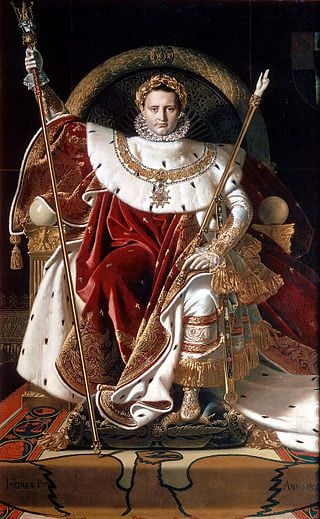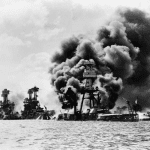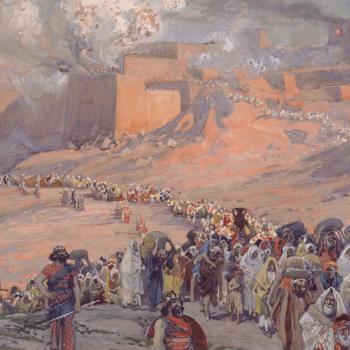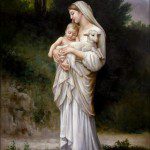
Jean Auguste Dominique Ingres
(Wikimedia Commons public domain image)
For convenience’s sake, Marshall Hodgson chose 1800 as the beginning of what he termed the “Modern Period” of Islamic history. But the event that he had in mind as marking the dawn of the Modern Period in the Middle East actually occurred in 1798. I quote from Paul Strathern’s fascinating Napoleon in Egypt:
The invasion of Egypt by Napoleon in the summer of 1798 was the first great seaborne invasion of the modern era. At the time, it may well have been the largest ever launched in the Western world — at least on a par with Xerxes’ vast Persian fleet which attacked Athens at the Battle of Salamis in 480 B.C., and certainly double the size of the sixteenth-century Spanish Armada which attempted to invade Elizabethan England. Yet unlike these predecessors, Napoleon’s invasion involved a long sea voyage of almost 2,000 miles. His armada consisted of 335 ships, ranging from towering battleships and fast frigates to lowly transports, from those bearing a cargo of just forty tons to those carrying over 400 tons. Each of these ships carried full crews, and in all the fleet was loaded with 1,200 horses, 171 field guns and an official roll-call of 35,000 soldiers. In fact, the number of soldiers was almost certainly nearer 40,000; Napoleon exploited the opportunity provided by four separate main embarkation ports — Toulon and Marseilles in France, Genoa and Civitavecchia in Italy — to surreptitiously increase the quota allowed him by the five-man Directory which ruled revolutionary France at the time. (1) . . . Napoleon spent much of the voyage . . . drawing up his plans for the invasion; this was his opportunity to emulate his hero, Alexander the Great. As he had confided to his secretary Bourrienne, prior to departure: “Europe is a molehill. . . . Everything here is worn out. My glory is slipping from my grasp, tiny Europe has not enough to offer. We must set off for the Orient; that is where all the greatest glory is to be achieved.”[1]
This was an ambitious undertaking, both militarily and politically. But, for all his many faults — I’m not even remotely a fan — Napoleon had ambitions far beyond the political and the military:
His primary [ostensible] purpose was to liberate the Egyptians from the oppressive rule of the Mamelukes. But this was only the beginning. Along with his soldiers he had brought with him a team of 167 hand-picked “savants”; these consisted of the young intellectual cream of France, comprising many of the country’s finest mathematicians, scientists, artists, writers and inventors. [2]
These were unexpected members of an armed expeditionary force, and the daily routine of the voyage was rather different than that of most conquering armadas:
Each morning Napoleon would decide upon a question for discussion that evening between himself, the senior savants and the generals traveling with him aboard L’Orient. Seated around a table, their faces dimly illuminated by lanterns, this collection of young ambitious soldiers and brilliant minds would discuss their leader’s chosen topics. These included “Is there life on other planets?,” “How will the world end?” and “How old is the earth?” (Ironically, the findings of the expedition would completely transform all previous knowledge of this latter subject.) . . . The debates would continue beneath the vast dome of the starlit heavens, as the ghostly looming canvases of the sails above them filled and slackened in the breeze. From the darkness all around came the shush of the passing waves and the creaking of the ship’s timbers as it shifted in the swell. . . . Occasionally Napoleon and his assembled staff and savants would listen to readings from various classic texts, which in turn would inspire their own topics for discussion. A reading from the Bible describing Joseph’s dream provoked a debate on whether dreams had meanings that could be interpreted. And after hearing a passage from Rousseau’s Discourse on the Origin of Inequality, there followed a debate lasting three nights on the social advantages and disadvantages of property.[3]
These “savants” would eventually create the enormously important multi-volume Description de l’Égypte — fully titled Description de l’Égypte, ou Recueil des observations et des recherches qui ont été faites en Égypte pendant l’expédition de l’armée française [“Description of Egypt, or the collection of observations and researches which were made in Egypt during the expedition of the French Army”]. The Description de l’Égypte is a series of publications that first began to appear in 1809 and continued until its final volume was issued in 1829. The goal of the project was to catalog all aspects of ancient and modern Egypt, including not only the country’s antiquities and its medieval monuments but its natural history. The volumes represent the collaborative effort of about 160 civilian scholars and scientists, along with that of roughly 2000 artists and technicians, including 400 engravers, and they mark the dawn of the serious modern study of Egyptian antiquities. Among other things, Napoleon’s expedition brought the famous tri-lingual Rosetta Stone to light, which, in turn, led to Jean-François Champollion’s decipherment of ancient Egyptian hieroglyphs. In certain respects, indeed, the results of the work of Napoleon’s savants retain considerable value still today.
And Napoleon was prepared to take any measures that he deemed necessary in order to fulfill his ambitions:
As the invasion fleet sailed east across the Mediterranean, Napoleon would lie in bed reading and dictating to Bourrienne. His principal reading was from the Koran. Like Alexander the Great before him, he intended to absorb the religion of the people over whom he would rule. He insisted that, if necessary, he himself was willing to become a Muslim — an intention that, at least initially, he would show every sign of wishing to fulfill. However, it should also be noted that in Napoleon’s shipboard library the Koran was shelved under “Politics.” At the same time, he also busied himself with dictating his “proclamation” to the Egyptian people:
In the name of Allah the merciful . . . People of Egypt, you will have been told that I come as an enemy of Islam. This is a lie . . . I have come to restore your rights and punish those who oppress you. . . . I worship God more than your oppressors; I respect Mohammed his prophet and the holy Koran. . . . The French are also true Moslems. The proof of this can be seen in the fact that they have marched against Rome and destroyed the throne of the Pope, who constantly incited the Christians to make war on all Moslems . . .
Prior to arrival, this proclamation would be translated into Arabic by one of the Orientalists amongst the savants and printed on the Arabic printing press which Napoleon was carrying on board L’Orient. (He had scoured Europe for an Arabic printing press; ironically, the only one he had managed to find was at the Papal Propaganda Office in Rome.) On arrival, he intended that his proclamation should be distributed amongst the Egyptians, and it was hoped that this would overcome the need for armed conflict. Such was to be the first step in the creation of his Oriental empire. As Napoleon later put it, when describing his feelings at this time: “I saw the way to achieve all my dreams. . . . I would found a religion, I saw myself marching on the way to Asia, mounted on an elephant, a turban on my head, and in my hand a new Koran that I would have composed to suit my needs. In my enterprises I would have combined the experiences of the two worlds, exploiting the realm of all history for my own profit.” [4]
[1] Paul Strathern, Napoleon in Egypt (New York: Bantam Books, 2008), 1, 3.
[2] Strathern, Napoleon in Egypt, 3.
[3] Strathern, Napoleon in Egypt, 4-5.
[4] Strathern, Napoleon in Egypt, 5-6.












